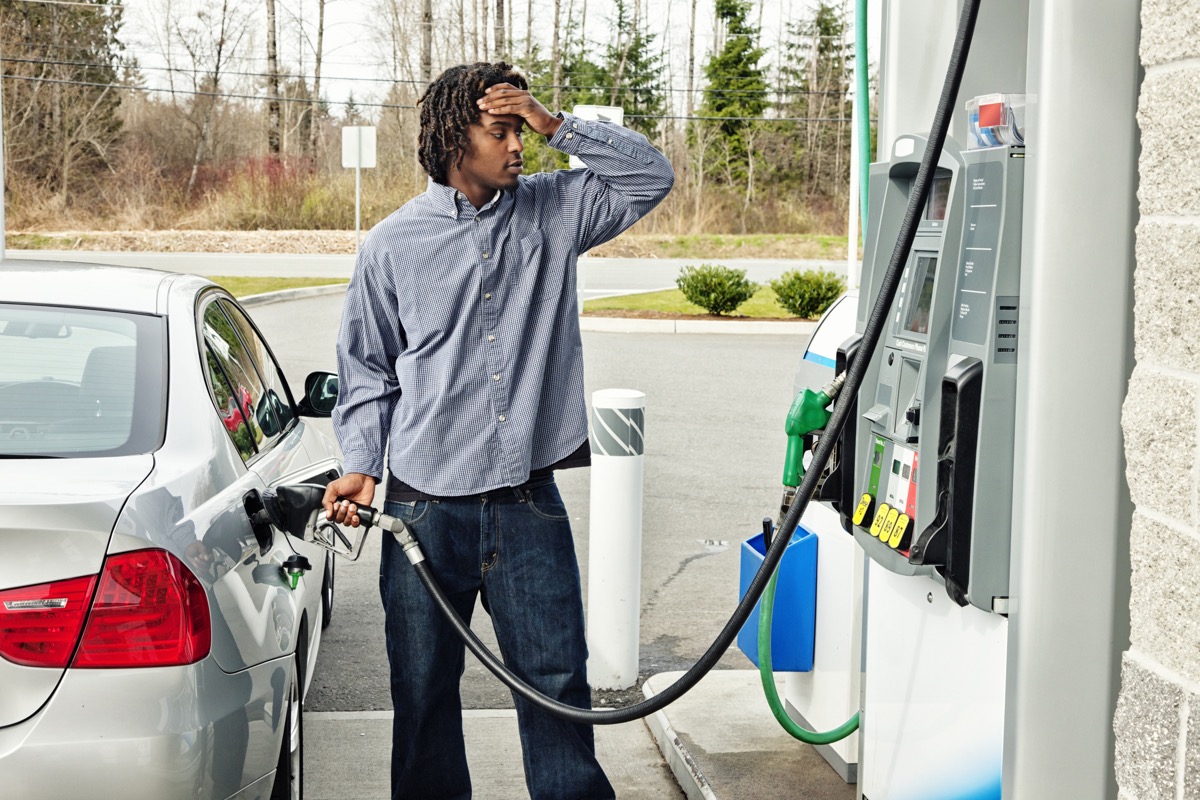Gas Prices Just Broke a New Record—Here’s How High They Could Get

Car ownership can be an expensive endeavor in and of itself. If it’s not costly repairs or monthly insurance payments, just keeping it filled with gas can put a strain on a budget if you rely on your vehicle to get around. But even if you carefully plan your trips and limit your time on the road, it’s impossible not to feel powerless when costs at the pump skyrocket. And with gas prices recently breaking records in the U.S., experts are now warning that they could get even higher soon. Read on to see how much you could end up forking over for your next fill-up.
RELATED: If Your Car Has This, Remove It Immediately, Police Warn.
The national average price for gas could hit $5 per gallon in the coming days.

Even if you don’t own a car, it’s been nearly impossible to ignore the discussion about the recent cost jump at the pump. According to the American Automobile Association (AAA), the national average for a gallon of regular gas is now $4.25, increasing from $4.17 the day before. The figure breaks the previous record of $4.11 per gallon set in July 2008—which would be around $5.25 when adjusting for inflation, USA Today reports. And it’s not just unleaded gas: The national average for diesel has also reached its all-time high, undergoing an even greater jump from $4.01 to $4.75 over the past seven days.
Unfortunately, experts caution that prices may not be done skyrocketing just yet. “We could see a national average of $5 a gallon,” Patrick De Haan, head of petroleum analysis at fuel-savings app GasBuddy, told CNN on March 8.
Several economic factors contribute to the suddenly skyrocketing cost of gasoline.

Even in relatively normal times, the price you pay at the pump is the result of many contributing factors, including supply chain woes—which famously drove up prices in May—or other real-world events. Experts say that this is especially the case now, with the combination of rising costs of transportation and goods caused by the COVID-19 pandemic meeting an increased demand for gasoline just as supplies run low.
“Jobs numbers have been pretty impressive, and a lot of [workers] will be driving to work somewhere,” Tom Kloza, global head of energy analysis for the Oil Price Information Service, told CNN. “There’s also going to be more people not working remotely than there were last year or even last month. I don’t know how to put a number on that, but that is certain to add to demand.”
The sudden increase in demand has even caught oil and gas companies off-guard, who have been slow to return production to pre-pandemic levels. Now, industry experts say they’re struggling to get back up to speed in the face of labor shortages and supply chain issues. “They can’t find people, and can’t find equipment,” Robert McNally, president of consulting firm Rapidan Energy Group, told CNN. “It’s not like they’re available at a premium price. They’re just not available.”
RELATED: For more up-to-date information, sign up for our daily newsletter.
The Russian invasion of Ukraine is making an already delicate situation even worse.

Even with post-pandemic conditions considered, the most notable element of the gas price equation would arguably be the Russian invasion of Ukraine. As one of the largest oil exporters globally, new economic sanctions on Russia have cut off its usual supply to other countries. And while very little Russian oil makes its way to the U.S. for consumption, it does make up about 27 percent of the European Union’s imports.
As a result, the situation has created an unprecedented surge in demand that has global consequences on the price of gas. “Even before Ukraine, I was expecting to break the record,” Kloza told CNN. “Now, it’s a question of how much we break the record by.”
Experts say there are still ways to cut back on gas and save money as prices surge.

It’s easy to feel helpless when pump prices increase. But according to experts, you can still get the most out of what’s in your tank by making sure your vehicle is running in top condition—even if you’re driving an older model or a large SUV. “The easiest way to impact fuel economy is to keep your tires at the proper pressure,” David Bennett, the manager of repair systems for AAA, told NBC News. “Having underinflated tires can decrease your gas mileage by 5 to 10 percent” due to the increase in “rolling resistance” created by soft tires.
And according to experts, where you buy your gas can also affect the final sale price. According to De Haan, it can be common to see smaller, independent gas stations selling gas at above-average prices due to their decreased sales volume compared to large chains. This can make it worth waiting to fill up your tank at places like Costco or Sam’s Club, where you may wait longer but stand to save about $5 on 16 gallons of gas, CNN reports.
RELATED: The One Car You Should Never Buy Used, According to 2021 Data.